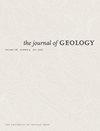拉达克-喜马拉雅地区印度河缝合带蛇绿岩浆岩晚期流体来源及静脉形成
IF 1.3
4区 地球科学
Q2 GEOLOGY
引用次数: 5
摘要
印度河缝合带Zildat蛇绿混杂岩(ZOM)和Shergol蛇绿混杂物(SOM)中的石英-方解石脉在蛇绿混杂形成的晚期保留了多种流体活动。本文介绍了这些矿脉的流体包裹体和同位素地球化学,以了解其压力和温度的来源和演化。石英和方解石脉的微观结构表明变形温度在200°C和400°C之间。ZOM和SOM的方解石脉的δ13C和δ18O值在混合模型中处于海洋和原始地幔场的混合双曲线范围内。ZOM方解石脉的Sr和Pb同位素值表明,脉形成的流体来源是大洋中脊玄武岩(MORB),该流体在超俯冲带中通过交代作用而放射富集。对于SOM,流体可能来源于富集地幔(EM)和贫化MORB地幔岩。据推断,碳酸流体来源于超镁铁质岩石和海洋地壳,形成了蛇绿混杂岩,这些岩石也含有这些矿脉。这些烃源岩具有同样在石英-方解石脉中获得的EM和MORB地球化学特征,其特征是其C-O-Sr-Pb同位素比率。岩浆盐水流体被推断是在矿脉形成的早期阶段形成的,随后被稀释,低盐水次生含水包裹体的存在就是例证。从所研究的剖面中对矿脉进行的微温流体压力-温度估计表明,在336°C时,矿脉流体的最大侵位深度约为24.5 MPa(相当于~2.5 km)。矿脉形成流体(钙质和硅质)被引入到由于变形而在宿主中发育的裂缝中。本文章由计算机程序翻译,如有差异,请以英文原文为准。
Tracing Late-Stage Fluid Sources and Vein Formation within Ophiolitic Mélanges from the Indus Suture Zone, Ladakh Himalaya
Quartz-calcite veins in the Zildat ophiolitic mélange (ZOM) and Shergol ophiolitic mélange (SOM) of the Indus Suture Zone preserve a diversity of fluid activity in the late stages of ophiolitic mélange formation. This article presents fluid-inclusion and isotope geochemistry of these veins to understand their source and evolution in terms of pressure and temperature. The microstructures of quartz and calcite veins indicate deformation temperatures between 200° and 400°C. The δ13C and δ18O values of calcite veins from the ZOM and SOM are within the mixing hyperbolas of marine and primitive-mantle fields in the mixing model. The Sr and Pb isotopic values of calcite veins from the ZOM suggest a mid-ocean ridge basalt (MORB) fluid source of vein formation that was radiogenically enriched by metasomatism in a suprasubduction zone. For the SOM, fluids may have originated from the enriched-mantle (EM) and the depleted-MORB-mantle rocks. It is inferred that the carbonic fluids were derived from ultramafic lithologies and oceanic crust that formed the ophiolitic mélange rocks, which also host these veins. These source rocks have EM and MORB geochemical signatures that are also obtained in the quartz-calcite veins, as characterized by their C-O-Sr-Pb isotopic ratios. The magmatic saline fluid is inferred to have formed in the early stages of vein formation and to have been subsequently diluted, as exemplified by the presence of low-saline secondary aqueous inclusions. The microthermometry fluid pressure-temperature estimation of veins from the studied sections suggests that the maximum depth of emplacement of veining fluid was about 24.5 MPa (corresponding to ∼2.5 km) at 336°C. The vein-forming fluids (calcareous and siliceous) were introduced into the fractures that developed in the host as a result of deformation.
求助全文
通过发布文献求助,成功后即可免费获取论文全文。
去求助
来源期刊

Journal of Geology
地学-地质学
CiteScore
3.50
自引率
5.60%
发文量
0
审稿时长
3 months
期刊介绍:
One of the oldest journals in geology, The Journal of Geology has since 1893 promoted the systematic philosophical and fundamental study of geology.
The Journal publishes original research across a broad range of subfields in geology, including geophysics, geochemistry, sedimentology, geomorphology, petrology, plate tectonics, volcanology, structural geology, mineralogy, and planetary sciences. Many of its articles have wide appeal for geologists, present research of topical relevance, and offer new geological insights through the application of innovative approaches and methods.
 求助内容:
求助内容: 应助结果提醒方式:
应助结果提醒方式:


